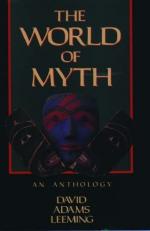
|
| Name: _________________________ | Period: ___________________ |
This test consists of 5 multiple choice questions, 5 short answer questions, and 10 short essay questions.
Multiple Choice Questions
1. Who was the oldest divine being in the Greek pantheon?
(a) Uranus.
(b) Chronos.
(c) Zeus.
(d) Gaia.
2. What is an ontological reason for myth?
(a) To understand the goal of existence.
(b) To understand existence.
(c) To compensate for the loss of instinct.
(d) To beautify existence.
3. How do the Greeks explain the presence of winter?
(a) Hera goes away on a trip.
(b) Demeter mourns for her daughter.
(c) Hades conquers earth.
(d) Zeus bans fertility.
4. For what does Leeming say the struggle among gods in the Egyptian pantheon is a metaphor?
(a) The expansion of trade in the Mediterranean.
(b) The invasion of Ethiopians in 2,200 BCE.
(c) Historical political and religious conflicts in 4,000 BCE.
(d) The human struggle against evil.
5. Who does Leeming say is the archetypal helper god in the Greco-Roman Pantheon?
(a) Epimetheus.
(b) Athena.
(c) Prometheus.
(d) Pan.
Short Answer Questions
1. How many gods and goddesses comprised the Greek pantheon?
2. What does Leeming say the flood was for in Mayan culture?
3. Whose child is Horus, in the Egyptian pantheon?
4. When was the New Testament book of Revelation likely composed?
5. What is the creation myth called in Mesopotamia?
Short Essay Questions
1. What contribution does Leeming say Hesiod made to Greek creation myths?
2. Why does Leeming say that cosmogonies are predominantly feminine?
3. How do different cultures describe the Apocalypse?
4. Describe the Hebrew creation myth.
5. How does Leeming describe the Greek pantheon?
6. When does Leeming say the Egyptian creation myths were repeated?
7. What stories or topics does Leeming include in the category of cosmic myths?
8. How does Leeming address the fall from grace or perfection in creation myths?
9. Who are the primary gods in the Egyptian pantheon?
10. How does Leeming define the gods?
|
This section contains 851 words (approx. 3 pages at 300 words per page) |

|




